A Literature Review of HIV Infection Reduction Strategies for Youths
VerifiedAdded on 2023/06/03
|6
|1341
|344
Literature Review
AI Summary
This literature review examines various strategies for reducing HIV infection among youths, drawing from multiple research articles. It highlights the importance of incorporating sexual risk-reduction approaches, facilitating HIV awareness, and encouraging HIV testing. The review also emphasizes the role of social protection interventions, such as parental support, free schooling, and cash transfers, in reducing risky sexual behavior driven by economic factors. Behavioral interventions delivered through schools and structural interventions addressing stigma, inequities, gender discrimination, and poverty are also crucial. Furthermore, the review underscores the significance of adolescent-friendly reproductive healthcare services and community engagement. Ultimately, a multi-faceted approach involving education, social support, and healthcare accessibility is necessary to effectively reduce HIV infection among the youth population. Desklib provides access to this and many other solved assignments.
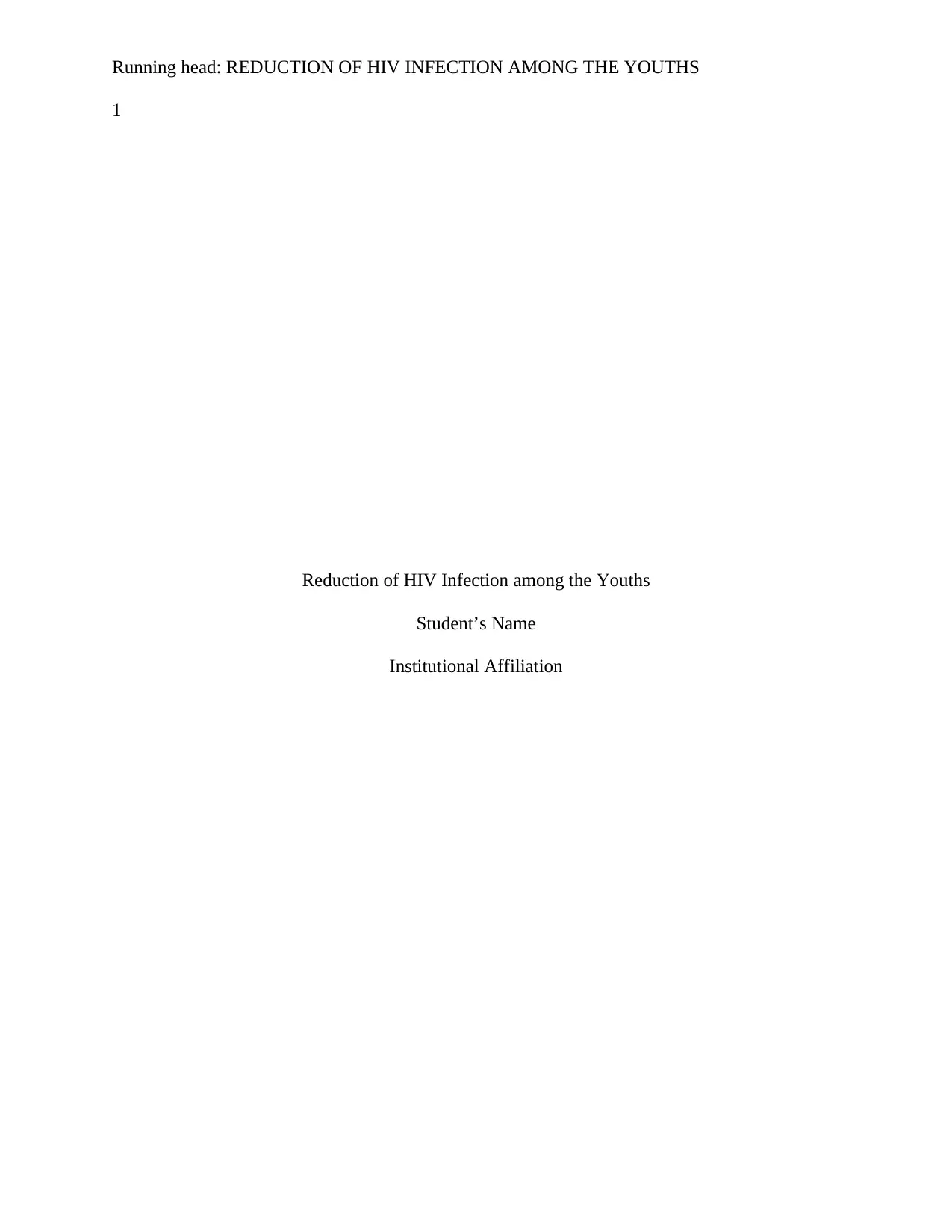
Running head: REDUCTION OF HIV INFECTION AMONG THE YOUTHS
1
Reduction of HIV Infection among the Youths
Student’s Name
Institutional Affiliation
1
Reduction of HIV Infection among the Youths
Student’s Name
Institutional Affiliation
Paraphrase This Document
Need a fresh take? Get an instant paraphrase of this document with our AI Paraphraser
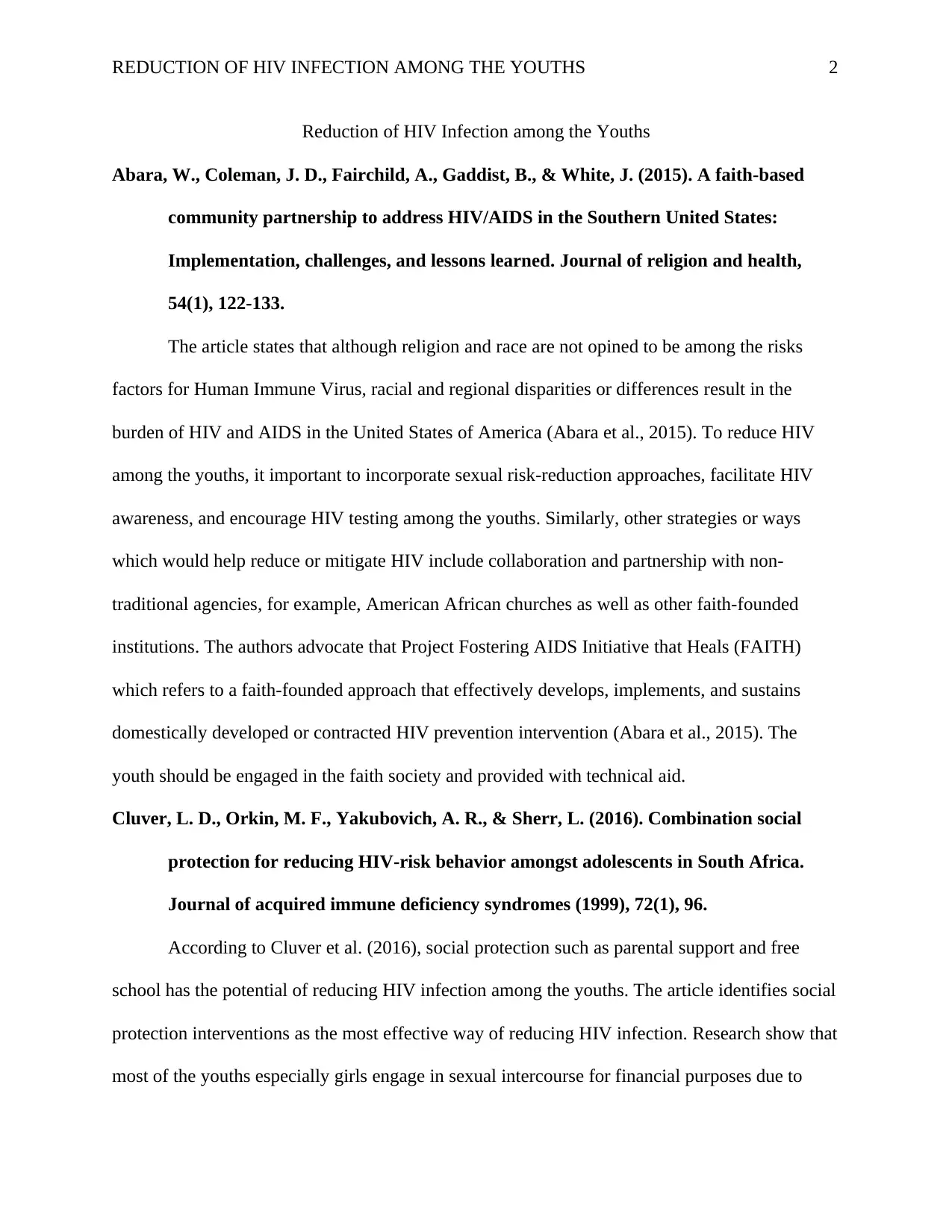
REDUCTION OF HIV INFECTION AMONG THE YOUTHS 2
Reduction of HIV Infection among the Youths
Abara, W., Coleman, J. D., Fairchild, A., Gaddist, B., & White, J. (2015). A faith-based
community partnership to address HIV/AIDS in the Southern United States:
Implementation, challenges, and lessons learned. Journal of religion and health,
54(1), 122-133.
The article states that although religion and race are not opined to be among the risks
factors for Human Immune Virus, racial and regional disparities or differences result in the
burden of HIV and AIDS in the United States of America (Abara et al., 2015). To reduce HIV
among the youths, it important to incorporate sexual risk-reduction approaches, facilitate HIV
awareness, and encourage HIV testing among the youths. Similarly, other strategies or ways
which would help reduce or mitigate HIV include collaboration and partnership with non-
traditional agencies, for example, American African churches as well as other faith-founded
institutions. The authors advocate that Project Fostering AIDS Initiative that Heals (FAITH)
which refers to a faith-founded approach that effectively develops, implements, and sustains
domestically developed or contracted HIV prevention intervention (Abara et al., 2015). The
youth should be engaged in the faith society and provided with technical aid.
Cluver, L. D., Orkin, M. F., Yakubovich, A. R., & Sherr, L. (2016). Combination social
protection for reducing HIV-risk behavior amongst adolescents in South Africa.
Journal of acquired immune deficiency syndromes (1999), 72(1), 96.
According to Cluver et al. (2016), social protection such as parental support and free
school has the potential of reducing HIV infection among the youths. The article identifies social
protection interventions as the most effective way of reducing HIV infection. Research show that
most of the youths especially girls engage in sexual intercourse for financial purposes due to
Reduction of HIV Infection among the Youths
Abara, W., Coleman, J. D., Fairchild, A., Gaddist, B., & White, J. (2015). A faith-based
community partnership to address HIV/AIDS in the Southern United States:
Implementation, challenges, and lessons learned. Journal of religion and health,
54(1), 122-133.
The article states that although religion and race are not opined to be among the risks
factors for Human Immune Virus, racial and regional disparities or differences result in the
burden of HIV and AIDS in the United States of America (Abara et al., 2015). To reduce HIV
among the youths, it important to incorporate sexual risk-reduction approaches, facilitate HIV
awareness, and encourage HIV testing among the youths. Similarly, other strategies or ways
which would help reduce or mitigate HIV include collaboration and partnership with non-
traditional agencies, for example, American African churches as well as other faith-founded
institutions. The authors advocate that Project Fostering AIDS Initiative that Heals (FAITH)
which refers to a faith-founded approach that effectively develops, implements, and sustains
domestically developed or contracted HIV prevention intervention (Abara et al., 2015). The
youth should be engaged in the faith society and provided with technical aid.
Cluver, L. D., Orkin, M. F., Yakubovich, A. R., & Sherr, L. (2016). Combination social
protection for reducing HIV-risk behavior amongst adolescents in South Africa.
Journal of acquired immune deficiency syndromes (1999), 72(1), 96.
According to Cluver et al. (2016), social protection such as parental support and free
school has the potential of reducing HIV infection among the youths. The article identifies social
protection interventions as the most effective way of reducing HIV infection. Research show that
most of the youths especially girls engage in sexual intercourse for financial purposes due to
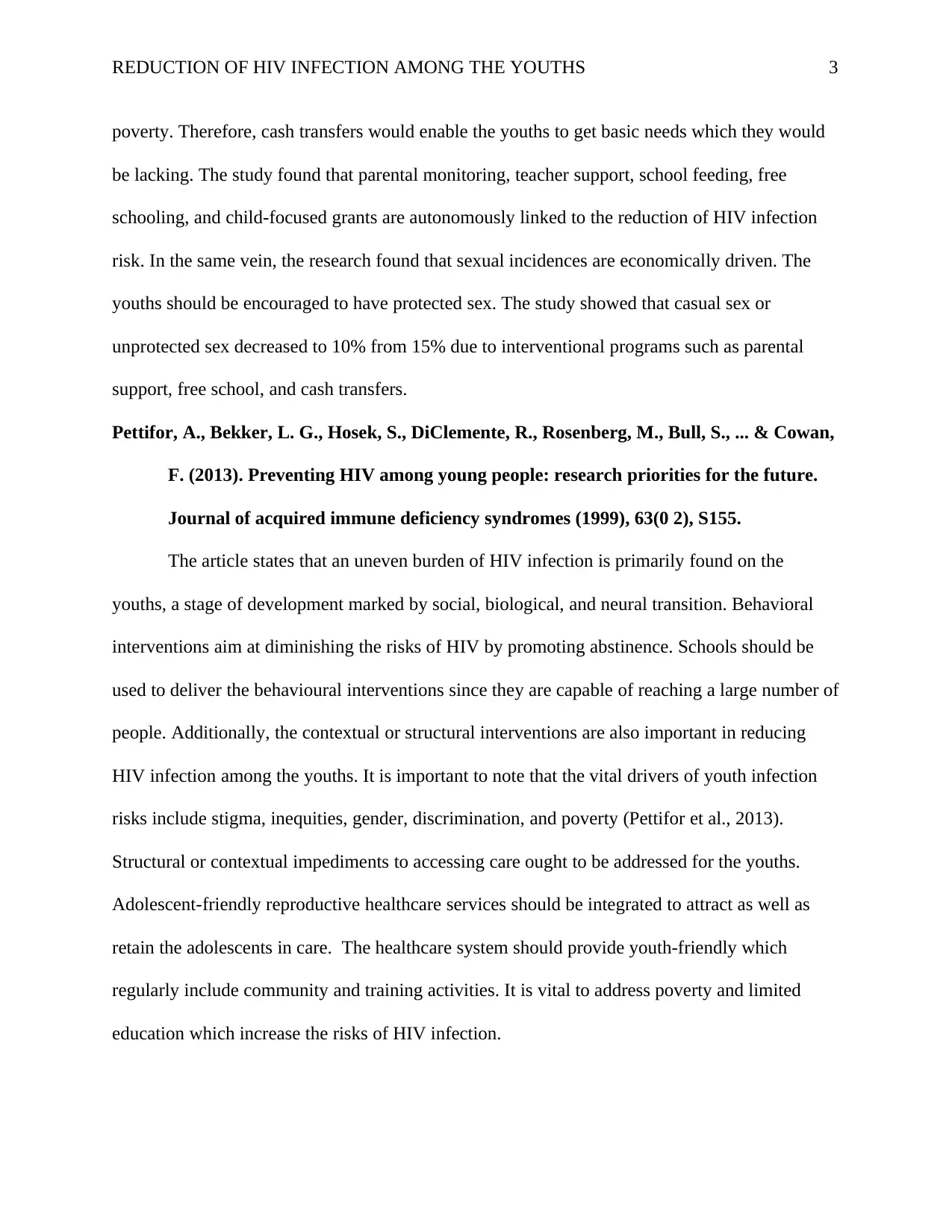
REDUCTION OF HIV INFECTION AMONG THE YOUTHS 3
poverty. Therefore, cash transfers would enable the youths to get basic needs which they would
be lacking. The study found that parental monitoring, teacher support, school feeding, free
schooling, and child-focused grants are autonomously linked to the reduction of HIV infection
risk. In the same vein, the research found that sexual incidences are economically driven. The
youths should be encouraged to have protected sex. The study showed that casual sex or
unprotected sex decreased to 10% from 15% due to interventional programs such as parental
support, free school, and cash transfers.
Pettifor, A., Bekker, L. G., Hosek, S., DiClemente, R., Rosenberg, M., Bull, S., ... & Cowan,
F. (2013). Preventing HIV among young people: research priorities for the future.
Journal of acquired immune deficiency syndromes (1999), 63(0 2), S155.
The article states that an uneven burden of HIV infection is primarily found on the
youths, a stage of development marked by social, biological, and neural transition. Behavioral
interventions aim at diminishing the risks of HIV by promoting abstinence. Schools should be
used to deliver the behavioural interventions since they are capable of reaching a large number of
people. Additionally, the contextual or structural interventions are also important in reducing
HIV infection among the youths. It is important to note that the vital drivers of youth infection
risks include stigma, inequities, gender, discrimination, and poverty (Pettifor et al., 2013).
Structural or contextual impediments to accessing care ought to be addressed for the youths.
Adolescent-friendly reproductive healthcare services should be integrated to attract as well as
retain the adolescents in care. The healthcare system should provide youth-friendly which
regularly include community and training activities. It is vital to address poverty and limited
education which increase the risks of HIV infection.
poverty. Therefore, cash transfers would enable the youths to get basic needs which they would
be lacking. The study found that parental monitoring, teacher support, school feeding, free
schooling, and child-focused grants are autonomously linked to the reduction of HIV infection
risk. In the same vein, the research found that sexual incidences are economically driven. The
youths should be encouraged to have protected sex. The study showed that casual sex or
unprotected sex decreased to 10% from 15% due to interventional programs such as parental
support, free school, and cash transfers.
Pettifor, A., Bekker, L. G., Hosek, S., DiClemente, R., Rosenberg, M., Bull, S., ... & Cowan,
F. (2013). Preventing HIV among young people: research priorities for the future.
Journal of acquired immune deficiency syndromes (1999), 63(0 2), S155.
The article states that an uneven burden of HIV infection is primarily found on the
youths, a stage of development marked by social, biological, and neural transition. Behavioral
interventions aim at diminishing the risks of HIV by promoting abstinence. Schools should be
used to deliver the behavioural interventions since they are capable of reaching a large number of
people. Additionally, the contextual or structural interventions are also important in reducing
HIV infection among the youths. It is important to note that the vital drivers of youth infection
risks include stigma, inequities, gender, discrimination, and poverty (Pettifor et al., 2013).
Structural or contextual impediments to accessing care ought to be addressed for the youths.
Adolescent-friendly reproductive healthcare services should be integrated to attract as well as
retain the adolescents in care. The healthcare system should provide youth-friendly which
regularly include community and training activities. It is vital to address poverty and limited
education which increase the risks of HIV infection.
⊘ This is a preview!⊘
Do you want full access?
Subscribe today to unlock all pages.

Trusted by 1+ million students worldwide
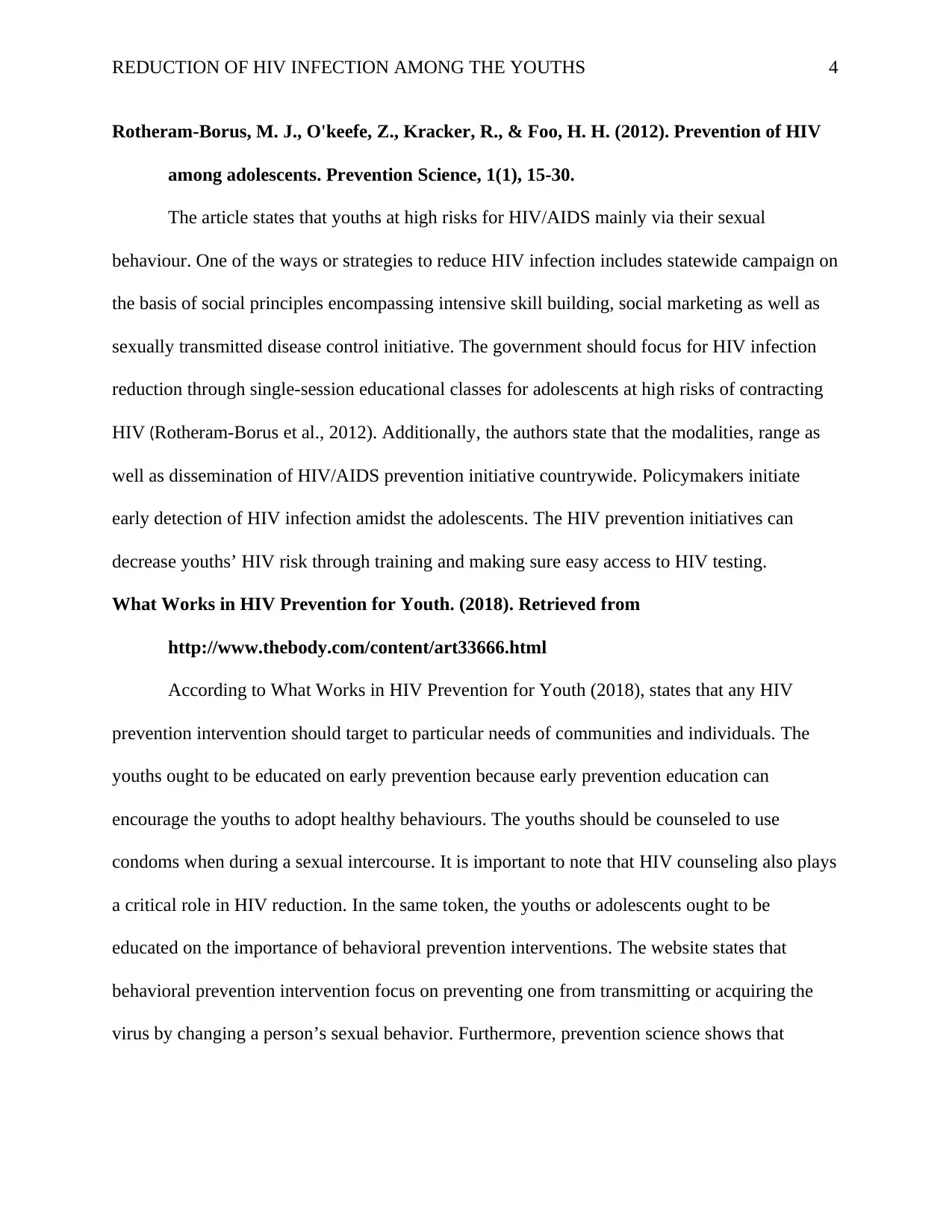
REDUCTION OF HIV INFECTION AMONG THE YOUTHS 4
Rotheram-Borus, M. J., O'keefe, Z., Kracker, R., & Foo, H. H. (2012). Prevention of HIV
among adolescents. Prevention Science, 1(1), 15-30.
The article states that youths at high risks for HIV/AIDS mainly via their sexual
behaviour. One of the ways or strategies to reduce HIV infection includes statewide campaign on
the basis of social principles encompassing intensive skill building, social marketing as well as
sexually transmitted disease control initiative. The government should focus for HIV infection
reduction through single-session educational classes for adolescents at high risks of contracting
HIV (Rotheram-Borus et al., 2012). Additionally, the authors state that the modalities, range as
well as dissemination of HIV/AIDS prevention initiative countrywide. Policymakers initiate
early detection of HIV infection amidst the adolescents. The HIV prevention initiatives can
decrease youths’ HIV risk through training and making sure easy access to HIV testing.
What Works in HIV Prevention for Youth. (2018). Retrieved from
http://www.thebody.com/content/art33666.html
According to What Works in HIV Prevention for Youth (2018), states that any HIV
prevention intervention should target to particular needs of communities and individuals. The
youths ought to be educated on early prevention because early prevention education can
encourage the youths to adopt healthy behaviours. The youths should be counseled to use
condoms when during a sexual intercourse. It is important to note that HIV counseling also plays
a critical role in HIV reduction. In the same token, the youths or adolescents ought to be
educated on the importance of behavioral prevention interventions. The website states that
behavioral prevention intervention focus on preventing one from transmitting or acquiring the
virus by changing a person’s sexual behavior. Furthermore, prevention science shows that
Rotheram-Borus, M. J., O'keefe, Z., Kracker, R., & Foo, H. H. (2012). Prevention of HIV
among adolescents. Prevention Science, 1(1), 15-30.
The article states that youths at high risks for HIV/AIDS mainly via their sexual
behaviour. One of the ways or strategies to reduce HIV infection includes statewide campaign on
the basis of social principles encompassing intensive skill building, social marketing as well as
sexually transmitted disease control initiative. The government should focus for HIV infection
reduction through single-session educational classes for adolescents at high risks of contracting
HIV (Rotheram-Borus et al., 2012). Additionally, the authors state that the modalities, range as
well as dissemination of HIV/AIDS prevention initiative countrywide. Policymakers initiate
early detection of HIV infection amidst the adolescents. The HIV prevention initiatives can
decrease youths’ HIV risk through training and making sure easy access to HIV testing.
What Works in HIV Prevention for Youth. (2018). Retrieved from
http://www.thebody.com/content/art33666.html
According to What Works in HIV Prevention for Youth (2018), states that any HIV
prevention intervention should target to particular needs of communities and individuals. The
youths ought to be educated on early prevention because early prevention education can
encourage the youths to adopt healthy behaviours. The youths should be counseled to use
condoms when during a sexual intercourse. It is important to note that HIV counseling also plays
a critical role in HIV reduction. In the same token, the youths or adolescents ought to be
educated on the importance of behavioral prevention interventions. The website states that
behavioral prevention intervention focus on preventing one from transmitting or acquiring the
virus by changing a person’s sexual behavior. Furthermore, prevention science shows that
Paraphrase This Document
Need a fresh take? Get an instant paraphrase of this document with our AI Paraphraser

REDUCTION OF HIV INFECTION AMONG THE YOUTHS 5
parents’ involvement is as well one of the effective strategies for reducing or mitigating
HIV/AIDS infection among the youths.
parents’ involvement is as well one of the effective strategies for reducing or mitigating
HIV/AIDS infection among the youths.
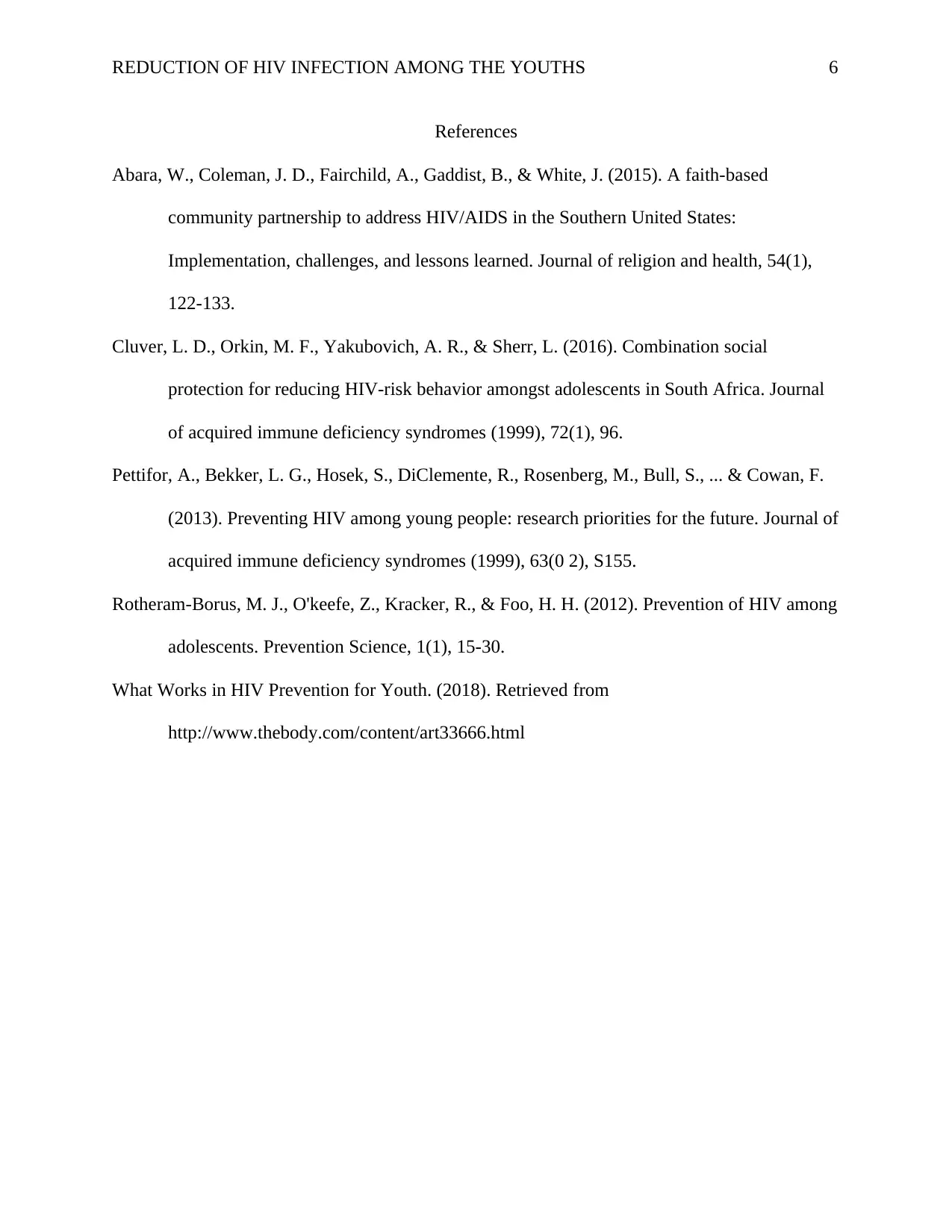
REDUCTION OF HIV INFECTION AMONG THE YOUTHS 6
References
Abara, W., Coleman, J. D., Fairchild, A., Gaddist, B., & White, J. (2015). A faith-based
community partnership to address HIV/AIDS in the Southern United States:
Implementation, challenges, and lessons learned. Journal of religion and health, 54(1),
122-133.
Cluver, L. D., Orkin, M. F., Yakubovich, A. R., & Sherr, L. (2016). Combination social
protection for reducing HIV-risk behavior amongst adolescents in South Africa. Journal
of acquired immune deficiency syndromes (1999), 72(1), 96.
Pettifor, A., Bekker, L. G., Hosek, S., DiClemente, R., Rosenberg, M., Bull, S., ... & Cowan, F.
(2013). Preventing HIV among young people: research priorities for the future. Journal of
acquired immune deficiency syndromes (1999), 63(0 2), S155.
Rotheram-Borus, M. J., O'keefe, Z., Kracker, R., & Foo, H. H. (2012). Prevention of HIV among
adolescents. Prevention Science, 1(1), 15-30.
What Works in HIV Prevention for Youth. (2018). Retrieved from
http://www.thebody.com/content/art33666.html
References
Abara, W., Coleman, J. D., Fairchild, A., Gaddist, B., & White, J. (2015). A faith-based
community partnership to address HIV/AIDS in the Southern United States:
Implementation, challenges, and lessons learned. Journal of religion and health, 54(1),
122-133.
Cluver, L. D., Orkin, M. F., Yakubovich, A. R., & Sherr, L. (2016). Combination social
protection for reducing HIV-risk behavior amongst adolescents in South Africa. Journal
of acquired immune deficiency syndromes (1999), 72(1), 96.
Pettifor, A., Bekker, L. G., Hosek, S., DiClemente, R., Rosenberg, M., Bull, S., ... & Cowan, F.
(2013). Preventing HIV among young people: research priorities for the future. Journal of
acquired immune deficiency syndromes (1999), 63(0 2), S155.
Rotheram-Borus, M. J., O'keefe, Z., Kracker, R., & Foo, H. H. (2012). Prevention of HIV among
adolescents. Prevention Science, 1(1), 15-30.
What Works in HIV Prevention for Youth. (2018). Retrieved from
http://www.thebody.com/content/art33666.html
⊘ This is a preview!⊘
Do you want full access?
Subscribe today to unlock all pages.

Trusted by 1+ million students worldwide
1 out of 6
Related Documents
Your All-in-One AI-Powered Toolkit for Academic Success.
+13062052269
info@desklib.com
Available 24*7 on WhatsApp / Email
![[object Object]](/_next/static/media/star-bottom.7253800d.svg)
Unlock your academic potential
Copyright © 2020–2025 A2Z Services. All Rights Reserved. Developed and managed by ZUCOL.





